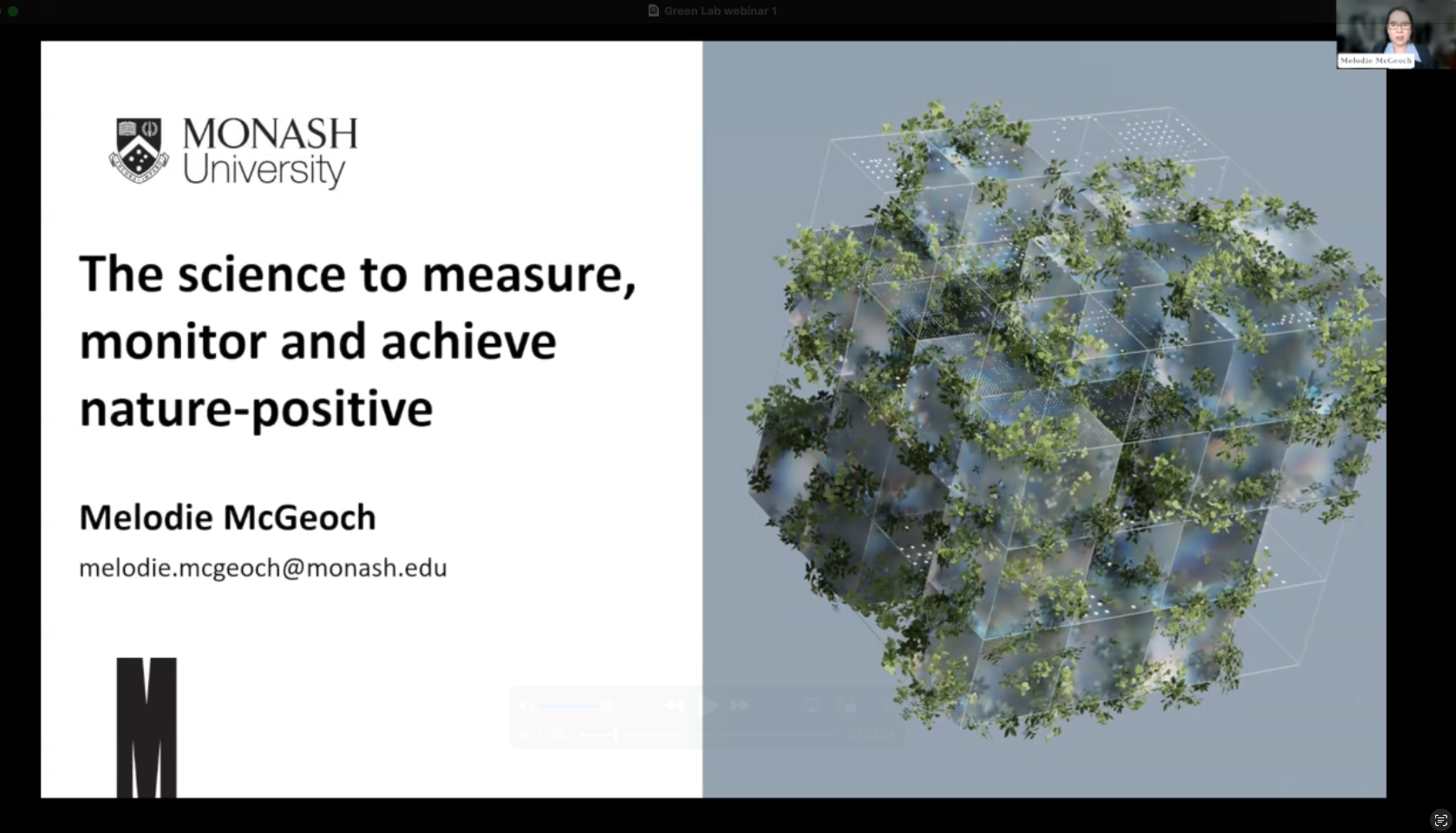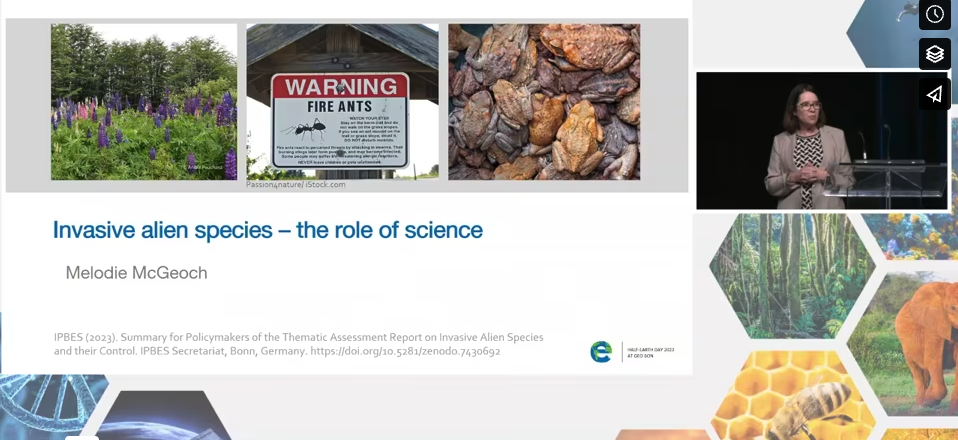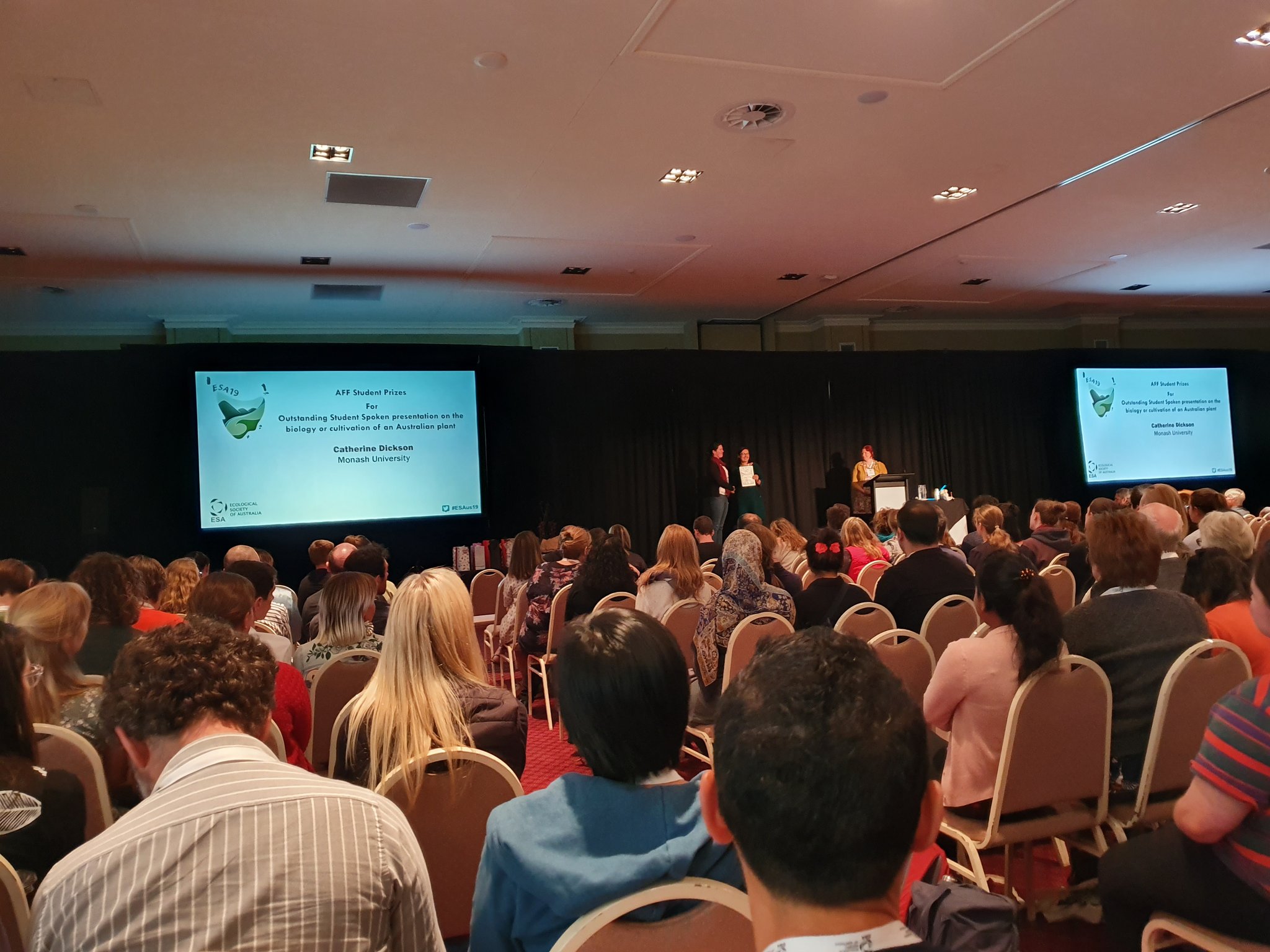October 2024
The science of Nature Positive
Melodie and Saxbee presented webinars for the Monash University series on A Nature Positive Australia – Why does it matter and how do we get there? Lab members spoke on the topic of “Nature – Science, data and information for a nature-positive Australia”, regarding “Do we have the scientific basis to measure and monitor nature-positive outcomes?”, and “Protecting species and natural processes for a nature positive Australia.”
Links: Webinar recordings – Google Drive
September 2024
GBIF task group
The Global Biodiversity Information Facility (GBIF) reconvened its task group on the mobilization and use of biodiversity data for research and policy on invasive alien species. Melodie chairs this group of 12 international experts to carry a remit to strengthen GBIF’s position on the science-policy interface, improve its coverage and representation of relevant data, and support the wider invasive alien species (IAS) research and policy communities.
Task group reconvenes to enhance biodiversity data for invasive species research and policy
Mid-2024
Call for joint work program on climate change and biodiversity
Members of the McGeoch laboratory joined ~140 other climate scientists, ecologists, social scientists, law and governance scholars and environmental management professionals to write to the Presidents, Conference of the Parties (COP 16) to the Convention on Biological Diversity (CBD) and the United Nations Framework Convention on Climate Change (UNFCCC COP29) calling to bridge the implementation gaps between the Kunming-Montreal Global Biodiversity Framework (GBF) and the Paris Agreement. Recommendations were made to setup a joint work programme between the CBD and the UNFCCC, and on how to initiate processes towards the creation of this much-needed joint policy framework. Better coordination and collaboration will aim to more successfully address the climate and nature crises and deliver the 2030 Agenda for Sustainable Development.
Guidance on Target 6 of the KM Global Biodiversity Framework
Melodie presented a webinar on the rate of invasive alien species establishment as one of the members of the ad hoc technical expert group (AHTEG) on indicators for the Kunming-Montreal Global Biodiversity Framework. Webinars described and discussed the outcomes of the AHTEG leading to and following the twenty-sixth meeting of the Subsidiary Body on Scientific, Technical and Technological Advice as part of the Convention on Biodiversity.
Webinar: Indicator 6.1 Rate of invasive Alien Species Establishment
GEOBON Conference on Monitoring Biodiversity for Action
Melodie took part in the session on Safeguarding Species in a Changing World: The Role of Science. Watch the session here.
September 2023
IPBES 10 Plenary
Professor Melodie McGeoch is Coordinating Lead Author on Chapter 6 of the assessment on policy option, of the IPBES Report. Melodie has been in Bonn, Germany attending the IPBES 10 Plenary, from the 28th of August to the 2nd of September 2023.
Over four years, 86 expert authors from 49 countries gathered the latest scientific evidence and Indigenous and local knowledge on invasive alien species. The report draws on more than 13,000 references, including governmental reports. What does the first global assessment of invasive alien species and their control, from IPBES, mean for us in Australia?
One of the goals of this report is to meet one of the targets in the Kunming-Montreal Global Biodiversity Framework is to “eliminate, minimise, reduce and/or mitigate the impacts of invasive alien species on biodiversity and ecosystem services”.
Australia already has close to 3,000 introduced alien species.
The assessment reveals that invasive alien species have contributed to 60% of global extinctions, and have been the sole driver of 16% of recorded extinctions. Australia has among the highest modern global native species extinction rates. Australia is the worst in the world for mammal extinctions, largely due to invasive species.
https://www.ipbes.net/IASmediarelease
August 2023
Australian Antarctic Program Expeditioner Summit
Dr David Clarke is a part of an incredible team of scientists in the Denman Glacier Campaign. From the 21st to the 25th of August he attended training in Hobart, Tasmania to prepare for the upcoming expedition.
The Denman Glacier is vulnerable to climate change and alone holds a potential sea level rise of 1.5 m. To understand this important region, the Australian Antarctic Division is preparing a camp to support a 3 year science mission.
Over the 2022–2023 summer, a small team of expeditioners is building huts and timber platforms for tents in the Bunger Hills, an ice-free area near the glacier.
A broad range of science will be conducted at the Denman Glacier, including:
- drilling and analysis of ice core records
- analysis of subglacial hydrology and composition
- collection and analysis of sediments to understand environmental histories
- geological studies of the deeper-earth
- ocean circulation and biogeochemical analysis
- remote sensing and airborne radar
- wildlife, microbial and biodiversity surveys
- landscape and ocean mapping
- deployment of autonomous monitoring stations

July 2023
XIII SCAR Biology Symposium 2023
Dr David Clarke attended the XIII SCAR Biology Symposium in Aotearoa (New Zealand) in Ōtautahi (Christchurch), from the 31st of July to the 4th of August 2023.
The conference was be enriched by the tikanga (traditions) and mātauranga (knowledge) of New Zealand’s indigenous knowledge (mātauranga Māori people) and a true dedication towards to sustainability.
David spoke on cryptic species diversity and the implications for biodiversity monitoring, with examples from Southern Ocean marine invertebrates.

May 2023
SAEF Annual Conference 2023
Prof. Melodie McGeoch, Dr David Clarke, and Samuel Beale attended the SAEF Annual Conference from the 9th to the 12th of May 2023.
The SAEF Annual Conference was a perfect opportunity to gather in person to discuss Antarctic and Southern Ocean science. Over three days, all SAEF members had their first chance to meet face-to-face to share research and discuss new opportunities for collaboration.

March 2023
B3 – Biodiversity Building Blocks for Policy
B3 – Biodiversity Building Blocks for Policy. Horizon Europe project funded by the European Union. “The project envisages a future where primary biodiversity data are seamlessly integrated into monitoring and forecasting such that policy and management can proactively respond to problems while at the same time reduce the costs of monitoring and management, and the negative impacts of biodiversity change”. Kickoff project meeting following project launch – 13-14 March 2023, Brussels, Belgium. Attended by Melodie McGeoch and David Clarke – representing La Trobe University (an Associate Partner on B3) and SAEF.

Sam Beale Goes South
Samuel Beale, a PhD student of Melodie’s, has spent the last six months on Macquarie Island undertaking a variety of plant surveys. One of Sam’s projects is on resurveying the Critically Endangered cushion-plant Azorella macquariensis. Which is a reassessment of Dr Cath Dickson’s 2016 work. Sam’s fieldwork also included looking at plant traits and how they can help in understanding the impacts of climate change. This involved conducting vegetation surveys across a range of sites on the island to get measures of species abundance as well as collecting plant samples to measure a key set of plant traits, like specific leaf area, plant height and chlorophyll content.

September 2022
sTWIST Final Meeting
The sTWIST group, led by Melodie McGeoch and Marten Winter, has had its third and final meeting in the week of 19th -23rd September 2022 in Leipzig, Germany. They met to present and discuss progress on several team projects, work on three different publications stemming from the McGeoch et al. (2021) preprint, entitled: Policy-relevant indicators for invasive alien species assessment and reporting.
April 2022
Melodie attended an Authors Meeting of the Invasive Alien Species Assessment of IPBES held in Aarhus, Denmark this April. She is coordinating lead author on policy options and responses for invasive alien species. The Assessment is due to be presented at the IPBES Plenary and released in 2023. It will provide decision makers with a state of the art analysis of the status and trends, impacts, drivers, management and options for policy to deal with the challenges of biological invasion.

On route to Aarhus, Melodie visited the GBIF Secretariat in Copenhagen to discuss options for using Antarctic biodiversity data to explore data standards for data with dimensions beyond species occurrences and sampling events – https://www.gbif.org/new-data-model. Melodie is First Vice-Chair of GBIF’s Science Committee.

December 2021
Impact and Action: A Virtual Science-Policy Symposium.
Impact and Action is a virtual science-policy symposium co-hosted by the Global Biodiversity Information Facility (GBIF), the U.S. National Science Foundation and the Organisation for Economic Co-operation and Development (OECD), examining how we strengthen and consolidate scientific impact in the next two decades and beyond.
The interconnected challenges of biodiversity loss and climate change have increased both the requirements and the pressing need for data to inform research and policy decisions, making GBIF’s mission more urgent than ever.
May 2021
Addressing uncertainty in impact assessments for alien species
 Impact classification schemes for alien taxa are becoming more prominent as the threats posed by biological invasions increase. Our recent study found that despite a high variety of uncertainties occurring in impact assessments, some of which cannot be eliminated easily, communicating their existence, cause and variety can lead to more useful and reliable outcomes of impact assessments. – Read the full article here
Impact classification schemes for alien taxa are becoming more prominent as the threats posed by biological invasions increase. Our recent study found that despite a high variety of uncertainties occurring in impact assessments, some of which cannot be eliminated easily, communicating their existence, cause and variety can lead to more useful and reliable outcomes of impact assessments. – Read the full article here
How to assess the impact of an invasive alien species – Download the pdf here
December 2020
Thank you to @MelodieAM, @August_Hao and @JaneElith for their presentations at the Atlas of Living Australia second 10th anniversary webinar.
If you missed out, you can watch these speakers discuss role of big data in managing Australian biodiversity here – https://youtu.be/zPgtpH8q3Bg
July 2020
The GEO BON Open Science Conference and All Hands Meeting 2020 was a milestone event that brought together all those involved and interested in the development of Biodiversity Observation Networks and Essential Biodiversity Variables, as well as their potential to support global biodiversity monitoring and conservation post 2020… Read more here.
Melody presented a keynote at the conference titled: What monitoring invasive species as taught us about governing biodiversity knowledge. Watch the keynote here.
June 2020

November 2019

March 2019
Global register aims to curtail the spread of invasive species – Monash Lens
Four decades ago, a small black and yellow wasp skipped across the equator from its native Europe and into Tasmania. Or did it?
The European wasp actually first arrived in New Zealand as early as the 1920s, and may have invaded Australia from there.
It probably travelled along with transport containers and packaging material. This invasive wasp – which stings people, damages crops, affects tourism and can destroy local wildlife – was first reported in Melbourne in the 1970s. Today it’s found across much of Australia.
Read more here – https://lens.monash.edu/2019/03/19/1373673/mapping-invasive-species
March 2019
Scientists develop new framework for global species monitoring
An international study involving a Monash biologist has outlined a much-needed framework to significantly improve the monitoring of status and trends of species worldwide. This finding comes after a multi-year collaboration under the auspices of the Group on Earth Observations Biodiversity Observation Network (GEO BON).
The study is published in Nature Ecology & Evolution.
Changes to biodiversity are already happening with severe potential consequences to all species, including humans, the researchers say.
The loss or invasion of a single species can dramatically alter the function of an entire ecosystem, explained Walter Jetz, lead author and Yale professor of ecology and evolutionary biology and of forestry and environmental studies.
Yet, current information about how and where species populations are changing on the planet remains “woefully inadequate,” according to study co-author Melodie McGeoch of Monash University, Australia.
“It lags far behind scientists’ monitoring of other aspects of environmental change,” she said.

Following in the footsteps of a similar approach in climate science to characterize core information, the researchers first identified “essential variables” for addressing species populations. These are standardized measures that with the aid of other information — such as that gathered by satellite-based remote sensing — and models integrate the often gap-ridden raw species data to give a clear picture of the distribution and abundance of species. The experts then laid out recommended practices that support this framework, such as better data sharing across national borders and enhanced collaboration between the varied parties involved in relevant data collection, from amateurs to government agencies.
“We are on the brink of a new age of sustainable knowledge delivery for life on our planet. As we show here, rapid developments in biodiversity data science and modelling will deliver benefits for decision makers via these essential variables for species populations”, said McGeoch.
“We hope that the presented concept and framework for global species monitoring will lay an important foundation for the collection and use of biodiversity data in support of conservation and resource management worldwide. Any agencies, businesses, conservation organizations, or international bodies concerned with the management of our lands and oceans would benefit from more reliable and representative information about the status and trends of species,” said Jetz.
The study’s suggestions also have the potential to help researchers themselves, he said. Improved global species monitoring would help close knowledge gaps that hinder present research that requires spatial biodiversity information, especially information about parts of the world and the tree of life that are hard to document through current practices.
Other authors include Robert Guralnick, Simon Ferrier, Jan Beck, Mark J. Costello, Miguel Fernandez, Gary N. Geller, Petr Keil, Cory Merow, Carsten Meyer, Frank E. Muller-Karger, Henrique M. Pereira, Eugenie C. Regan, Dirk S. Schmeller, and Eren Turak.
The study was developed with support from GEO BON and the German Centre for Integrative Biodiversity Research, iDiv. Additional funding was provided by grants from the National Science Foundation and the National Aeronautics and Space Administration.
Citation:
Essential biodiversity variables for mapping and monitoring species populations.
Jetz, W., McGeoch, M.A., Guralnick, R., Ferrier, S., Beck, J., Costello, M.J., Fernandez, M., Geller, G.N., Keil, P., Merow, C., Meyer, C., Muller-Karger, F.E., Pereira, H.M, Regan, E.C., Schmeller, D.S., Turak, E. 2019. Essential biodiversity variables for mapping and monitoring species populations. Nature Ecology & Evolution. Doi: 10.1038/s41559-019-0826-1
https://doi.org/10.1038/s41559-019-0826-1
Other media releases
https://news.yale.edu/2019/03/11/experts-present-new-framework-global-species-monitoring
September 2018
News from New Haven
Melodie McGeoch is visiting Walter Jetz and his lab at Yale this semester (https://jetzlab.yale.edu/).
Walter and his group work on patterns and processes in the distribution of the multiple dimensions of biodiversity, and the development of infrastructure and methods to support robust, repeatable analysis of biodiversity information (https://mol.org/species/).
Walter and Melodie co-chair the Species Populations Working Group of GEO BON (https://geobon.org/ebvs/working-groups/species-populations/), and are collaborating on delivering global information on alien and invasive species.
Melodie’s sabbatical visit is supported by Monash University and the Max Planck-Yale Center for Biodiversity Movement and Global Change (https://mpyc.yale.edu/).

Walter Jetz (Professor, Dept. of Ecology & Evolutionary Biology, Yale University) and Melodie McGeoch (Professor, School of Biological Sciences, Monash University).
May 2018
New funding for Invasions Indicator Development
Work under the GEOBON Species Populations Working Group (https://geobon.org/ebvs/working-groups/species-populations/) has just received a major boost with funding received by sDiv, the Synthesis Centre of iDiv, the German Centre for Integrative Biodiversity Research.
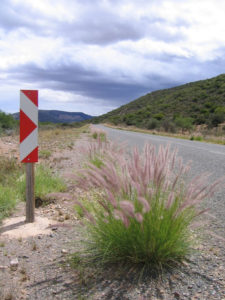
Invasive alien fountain grass (Pennisetum setaceum) invading road verges in the arid interior of South Africa. Photo credit M.A. McGeoch
The successful proposal – Theory and Workflows for Alien and Invasive Species Tracking (sTWIST), led by Melodie McGeoch (Monash University) and Marten Winter (iDiv), will integrate theory, frameworks and data to produce alien and invasive species indicators. This work also contributes to the ongoing efforts of the IUCN SSC ISSG (see this Scientific Data article and griis.org ) to improve information and data delivery on alien and invasive species.
The sTWIST Project is supported by an international team of experts in invasion biology, ecoinformatics and biodiversity modelling, and will kickstart with a workshop at iDiv, in Leipzig in August 2018.
Graduation day for Marie Henriksen.
Congratulations Dr. Henriksen on the completion of your PhD! Marie is a network ecologist with a particular interest in the spatial dynamics of networks, network metrics, host-parasitoid networks and biological control.
January 2018
Our paper on the Global Register of Introduced and Invasive Species has been published. Have a look underneath for links to the paper, a ‘Behind the Paper’ blog overview, and some other media coverage.
 Introducing the global register of introduced and invasive species
Introducing the global register of introduced and invasive species
Behind the Paper blog
What is it, where is it and how do we know? – Country listing of invasive species – Read more here
GRIIS (Global Register of Introduced and Invasive Species) Website – http://griis.org/
GBIF – Checklist Datasheets – Read more here
Other media coverage:
Global Biodiversity Information Facility (GBIF) Press release. – Read more here
IUCN Press release – Read more here
The Guardian – Read more here
May 2017
The Right Tool for the Job: Using Zeta Diversity to Communicate Uncertainty in Ecological Modelling
Despite how far modelling has taken us in science, the use of models remains controversial. Modelling covers a huge range of common practices, from scaled models of ships to determine the shape that will have the least resistance to water to complex, comprehensive ‘models of everything’. A great example of the latter is the Earth System Model. This model aims to understand the changes in global climate by taking into account the interaction between physical climate, biosphere, the atmosphere and the oceans. Basically, a model of how the Earth works.
Read more on the Official blog of Methods in Ecology and Evolution
May 2017
Capturing the Contribution of Rare and Common Species to Turnover: A Multi-Site Version of Generalised  Dissimilarity Modelling.
Dissimilarity Modelling.
Understanding how biodiversity is distributed and its relationship with the environment is crucial for conservation assessment. It also helps us to predict impacts of environmental changes and design appropriate management plans.
Read more on the Official blog of Methods in Ecology and Evolution
March 2017
Chance discovery triples critically endangered plant population

The delicate ‘terminal’ flowers and fleshy leaves distinguish Galium antarcticum from other Galium species. (Photo: Alex Fergus)
A new population of a critically endangered plant species has been discovered on sub-Antarctic Macquarie Island, tripling the previously known population to some 1500 plants.
The tiny, herbaceous Galium antarcticum (‘sub-Antarctic bedstraw’), was recently discovered by chance at Skua Lake, near the central west coast of the Island, by Monash University PhD student Cath Dickson. – Read more here
February 2017
Field work kicks off to better understand patterns of dieback in the Macquarie Cushion
 In December 2016 project team members Dr Dana Bergstrom (AAD), Dr Jennie Whinam (UTas) and Cath Dickson (PhD student, Monash) began field work on Macquarie Island to determine the distribution and abundance of potential refugia for Azorella macquariensis. December 2016 set three monthly weather records, which resulted in a very wet, windy start to the field season. However, despite the weather the team succesfully established half of the temperature and humidity data-loggers and refined the field methods before the New Year. – Read more about the project here
In December 2016 project team members Dr Dana Bergstrom (AAD), Dr Jennie Whinam (UTas) and Cath Dickson (PhD student, Monash) began field work on Macquarie Island to determine the distribution and abundance of potential refugia for Azorella macquariensis. December 2016 set three monthly weather records, which resulted in a very wet, windy start to the field season. However, despite the weather the team succesfully established half of the temperature and humidity data-loggers and refined the field methods before the New Year. – Read more about the project hereDecember 2016
 Experts outline strategy for improving alien species information
Experts outline strategy for improving alien species informationNovember 2016
 PhD student Cath Dickson recently presented a poster on Nowhere to hide? Conservation options for the sub-Antarctic Macquarie cushions. Developing the evidence base for management at the 11th Australasian Plant Conservation Conference. Cath investigated the response of the Azorella genus to climate change across the sub-Antarctic and South American sub-continent.
PhD student Cath Dickson recently presented a poster on Nowhere to hide? Conservation options for the sub-Antarctic Macquarie cushions. Developing the evidence base for management at the 11th Australasian Plant Conservation Conference. Cath investigated the response of the Azorella genus to climate change across the sub-Antarctic and South American sub-continent.August 2016
Survey seeks input on using and publishing data on invasive alien species
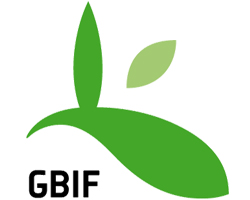 The GBIF task group on data fitness for use in research on invasive alien species (IAS) is seeking survey responses from data users and data holders intended to help improve both the suitability and the access to data for use in invasion biology and related fields.
The GBIF task group on data fitness for use in research on invasive alien species (IAS) is seeking survey responses from data users and data holders intended to help improve both the suitability and the access to data for use in invasion biology and related fields.
Through the 21-question survey, which should take 15-20 minutes to complete, the task group aims to document limitations in existing GBIF services, improve the utility of GBIF-mediated data and get suggestions on functional improvements needed to support better IAS-related research.
June 2016
March-April 2016
December 2015
 Cang Hui (collaborator and Professor of Mathematical Sciences at Stellenbosch University) visited the group for three weeks on our joint Discovery Project on the long-term consequences of multispecies invasion. One week at Monash University and the following two at the Ecological Society of Australia Annual Conference in Adelaide (29 Nov-3 December 2015), and the EcoStats Conference (co-organised by Melodie) at UNSW in Sydney.
Cang Hui (collaborator and Professor of Mathematical Sciences at Stellenbosch University) visited the group for three weeks on our joint Discovery Project on the long-term consequences of multispecies invasion. One week at Monash University and the following two at the Ecological Society of Australia Annual Conference in Adelaide (29 Nov-3 December 2015), and the EcoStats Conference (co-organised by Melodie) at UNSW in Sydney.
 gs provided a great opportunity to profile the value and application of zeta diversity (Hui & McGeoch 2014) and Melodie, Cang, Guillaume Latombe (Monash Unviersity) and Mariona Roige (Lincoln University) all presented work on zeta diversity and its broad range of potential applications, including its use in pest risk assessment.
gs provided a great opportunity to profile the value and application of zeta diversity (Hui & McGeoch 2014) and Melodie, Cang, Guillaume Latombe (Monash Unviersity) and Mariona Roige (Lincoln University) all presented work on zeta diversity and its broad range of potential applications, including its use in pest risk assessment.
October 2015
Eco-Stats ’15: Technological advances between Ecology and Statistics – Early bird deadline closing soon!
8-10 December 2015 – the week after ESA!
The University of New South Wales, Sydney, Australia
Register now – early-bird rates close Friday October 23rd
Ecologists and statisticians have much to gain from working together, and this conference is designed to provide precisely such an opportunity. This conference is a follow-up to the 2013 meeting*, and has been designed as a collaborative forum for researchers with interests in ecology, statistics, or both. Formal proceedings will start on December 8th with “Skills-Building Day”, a series of computer-based tutorials run across topics spanning the interests of conference speakers.
Then world leaders from ecology and statistics have been paired up to present their own perspectives on six topical issues (analysis of metagenomics data in ecology, occupancy modelling with imperfect detection, analysing counts along stream networks, modern capture-recapture, estimating biodiversity turnover, and modelling strategic behaviour during animal combat), and round-table discussions will workshop opportunities for interdisciplinary collaboration on these topics. Also featured will be a contributed poster session where participants can turn the topic of conversation to their own research. Invited speakers include:
– Otso Ovaskainen (University Helsinki)
– Douglas Yu (University of East Anglia)
– Darryl Mackenzie (Proteus Wildlife Research Consulting)
– Jay ver Hoef (NOAA Alaska)
– Melodie McGeoch, Paul Sunnucks (Monash University)
– Cang Hui (Stellenbosch University)
Further details at http://www.eco-stats.unsw.edu.au/ecostats15.html
Want to present in the poster session? Abstract submission deadline extended, closes October 23rd.
Already coming and want to study up on our speakers? Visit the study blog for speaker reading list and discussion
http://eco-stats15.blogspot.com.au/
August 2015
”Keeping on top of invasive species” – Radio Inverview
Listen to it here – http://www.abc.net.au/
June 2015
Read more about the The Monaco Assessment meeting here.
Zeta-diversity R package
The “zetadiv” R package, which contains functions to compute compositional turnover using zeta-diversity, the number of species shared by multiple assemblages, is now available on CRAN (http://cran.r-project.org/web/packages/zetadiv/).
The package includes a Zeta.order() function to compute zeta-diversity for a specific number of assemblages, and a Zeta.decline() function to compute zeta-diversity for a range of numbers of assemblages.
It also includes additional functions to explain how zeta-diversity varies with distance and with differences of environ- mental variables between assemblages, using linear regressions and generalized additive models.
March, 2015
GEO BON Workshop 2 – 4th March, 2015, Leipzig, Germany
Towards a global system for assessing, monitoring and reporting on biological invasions
Invasive alien species cost the taxpayer billions each year and are second only to habitat transformation in documented severity of impacts on biodiversity. Despite this, there is currently no system in place for the systematic evaluation and monitoring of invasive alien species. To improve knowledge and information in this field, Melodie McGeoch (Monash University, Australia) and Piero Genovesi (IUCN Invasive Species Specialist Group) organised a workshop in close collaboration with GEO BON and iDiv. Participants worked towards three main aims: First, to identify and agree on a minimum set of Essential Biodiversity Variables to form the basis of a global observation system for biological invasions. Second, to develop guidelines for national schemes to support impact classification and Aichi Target 9 of the Strategic Plan for Biodiversity (2011-2020). Third, to progress implementation of the IUCN alien impact classification scheme.
LINK TO WORKSHOP REPORT IN BLACKLISTING PAGE

Participants (from left to right): Miguel Fernandez, Guilluame Latombe, Marten Winter, John Wilson, Jan Pergl, Donald Hobern, Petr Pyšek, Jonathan Jeschke, Melodie McGeoch, Tim Blackburn, Sabrina Kumschick, Sven Bacher, Riccardo Scalera, Piero Genovesi, Junko Shimura, César Capinha, Helen Roy, Cang Hui
February 2015
PhD candidate Mariona Roigé visits the McGeoch Lab
Mariona is a PhD candidate from Lincoln University (New Zealand) focussing her research on the structure of global invasive species assemblages and their relationship to regional habitat variables. She was recently awarded the Bio-Protection Research Centre travel grant (Lincoln University) which is designed to support high achieving postgraduate students to develop a network of collaborations and research links. During her three-week stay Mariona presented her research, involved herself with the work of the other PhD students and staff of the McGeoch lab and engaged in interesting and productive discussions about potential collaborative projects between the two research teams. The overall outcome of Mariona’s stay is an ongoing collaborative project developing an analytical approach to prioritise invasive species in terms of their risk.
November 2014


November 2014

October 2014
ESA 2014 – Ecological Society of Australia Annual Conference in Alice Springs

Two of us presented at the Alice Springs meeting last week.
Melodie presented the AERA Lecture on Monday titled “Smart heuristics for applied ecology”.
and Guillaume spoke on Tuesday about “Disentangling the interactions between neutral and niche processes using the filter paradigm”. – Read the Abstract here
August 2014
The project “Black Listing Invasive Species for Monitoring and Reporting” has received support from GEO BON, as part of their activities to illustrate the value of Essential Biodiversity Variables [http://www.
In April 2014, GEO BON announced its first open call for small projects to support the developments of EBV’s and monitoring guidelines. Twenty-four excellent proposals had been submitted from all over the world asking together for about 1.2 Million Euro. But sadly, only about 120.000 Euro were available for this call. We had three, very serious selection rounds and applied different criteria. To find a consensus on which projects to support was really a challenge.
Finally, we selected these five proposals:
-
- Black Listing Invasive Species for Monitoring and Reporting submitted by Monash University
-
- BON in a Box submitted by the Humboldt Institute,
-
- Developing guidelines for standardised global butterfly monitoring, submitted by UNEP-WCMC and Dutch Butterfly Conservation
-
- Finalizing, visualizing and communicating global remote-sensing supported species EBVs and change indicators submitted by Yale University.
- Remote sensing of Essential Biodiversity Variables submitted by Twente University
Meanwhile we have started the negotiations with the institutes winning the competition and the GEO BON community will be regularly updated on the success of these GEO BON projects.
![]()
June 2014
The McGeoch Research Group was awarded two Parks Victoria Research Partners Program (RPP) grants. The RPP is designed to encourage and support research on park management and conduct applied research to improve park management and ecological understanding. – Read more here
The projects will involve research on (1) the biocontrol of Sallow Wattle in the Grampians National Park and (2) a decision support framework for invasion management priorities within and across parks in Victoria.
June 2014
Diane Srivastava (University of British Columbia) adding a buzz to our lab group discussions while on sabbatical at Monash.

May 2014
Chris McGrannachan awarded Bill Borthwick Scholarship for his PhD on the functional consequences of multispecies invasion.
Victorian Environmental Assessment Council. Royal Society of Victoria, Melbourne. Congratulations Chris!



